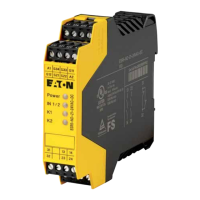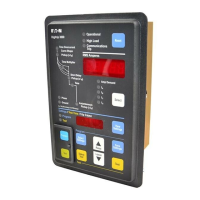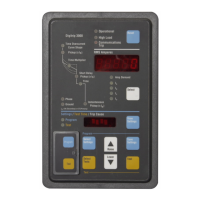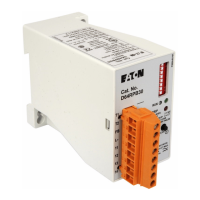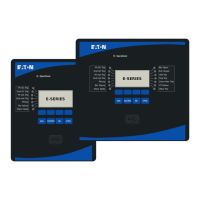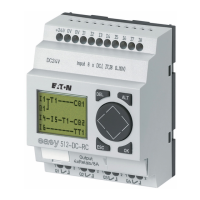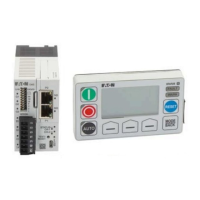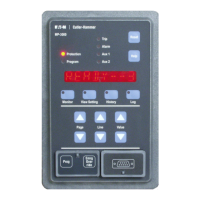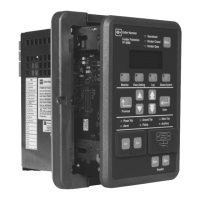I.B. 17555C
Effective November 1999
Page 15
• Switch S1 is used to select whether the IMPACC buff-
ers are set for the Digitrip 3000 configuration or the
Digitrip MV configuration. (Refer to Section 5: for con-
figuring the Digitrip 3000 as a replacement for a Dig-
itrip MV.)
• Switch S2 is used to enable/disable the ability to pro-
gram the setpoints when the breaker is in the open or
closed position.
CAUTION
CARE MUST BE TAKEN WHEN PROGRAMMING THE
DIGITRIP 3000 WHILE THE BREAKER IS CLOSED
AND CURRENT IS FLOWING. AN INCORRECT SET-
TING CONFIGURATION COULD CAUSE THE RELAY
TO TRIP THE BREAKER WHEN SETTINGS ARE
SAVED.
• Switch S3 is used to configure the trip contacts as
shown below:
Trip Contacts Dip Sw. OFF Pos. Dip Sw. ON Pos.
TB 12 & 13 Phase & Ground Trip Inst.Ground Trip Inst./OC
TB 14 & 15 Phase & Ground Trip 00/ Phase Trip Inst./OC/
Communications Communications
• Switch S4 is used to enable/disable the ability to open
or close the breaker remotely from the communica-
tions interface (host computer).
• Switch S5 is used to configure the Communication
Close output relay at terminals TB2-4 & TB2-5. When
S5 is in the “On” position, the output relay is pro-
grammed for High Load Alarm. When S5 is in the “Off”
position, the output relay is programmed for Communi-
cations Close.
• Switch S8 is used to enable/disable the ability to down-
load setpoints from the communication interface (host
computer).
• Switch S9 is used to select whether the relay should
be self-reset or manually reset (lock out function). For
additional details refer to the following paragraphs enti-
tled “Manual Reset” and “Auto Reset.”
• Switches S6, S7 and S10 are reserved.
Manual Reset: (DIP Switch S9 OFF) In this mode the
Trip Instantaneous contact (TB2 12 and 13), Trip Over-
current contact (TB2 14 and 15) and the Trip Alarm con-
tact (TB2 6, 7 and 8) change state after a protection trip
operation. The contacts stay in that state until the “Reset”
Pushbutton is depressed. In addition, the front panel will
hold the cause of trip in the “Trip Cause” window and the
fault current magnitude in the “RMS Ampere” window
until the “Reset” pushbutton is depressed. A RESET
COMMAND can be sent to the Digitrip 3000 by a master
computer to remotely reset the Digitrip 3000.
Auto Reset: (DIP Switch S9 ON) In this mode the Trip
Instantaneous contacts (TB2 12 and 13) or Trip Overcur-
rent contacts (TB2 14 and 15) are momentarily closed
after a protection trip operation. The contacts will remain
closed until the breakers 52b auxiliary switch contact
closes. The Trip Alarm Relay, however, remains ener-
gized until the “Reset” Pushbutton is depressed or a
RESET COMMAND is received from a communication
system master. In this mode after a trip is initiated and
the breaker has opened, the display will BLINK the cause
of the trip in the “Trip Cause” window and the “RMS
Ampere” window will show the fault current magnitude.
Both displays clear when the circuit breaker is reclosed.
Communicating LED: A red LED just above terminal
block (TB2) is used when the relay is communicating. If
the relay is the type designed to accept field installation
of a communication module at a later date, this LED is
not functional at any time.
Terminal Block One (TB1): TB1 is located on the left
side of the rear panel, and is numbered 1 through 15,
with 1, 2, 3, 7 and 8 not used.
Terminals 5 and 6 are provided for the AC or DC input
control power connections and Terminal 4 is the connec-
tion for equipment ground.
Terminal 9 and 10 provide for connection to a required
dry 52b contact and to a 52 TOC contact from the circuit
breaker.
When the relay has input control power, Terminals 9
and 10 will have this potential on them.
Terminals 11 and 12 are used for ground zone interlock-
ing, inverse time overcurrent protection and short delay
protection. The zone interlocking function is a low level
DC signal used to coordinate with “downstream” and
“upstream” breakers that see or do not see the fault. If the
function is not used but a inverse time overcurrent or
short delay time is desired, the two terminals should stay
jumpered as they were when shipped from the factory.
Terminals 13 and 14 are used for phase zone interlock-
ing, inverse time overcurrent protection and short delay
protection.
Terminal 15 is the zone signal common. Zone common
should never be connected to earth ground.
Refer to Figure 4-1 for a typical phase zone interlocking/
wiring scheme.
